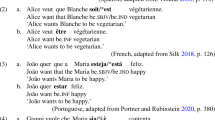Conclusion
I hope I have convinced the reader that DR theory offers at least some exciting potential when applied to the semantics of belief reports. It differs considerably from other approaches, and it makes intuitively acceptable predictions that other theories do not. The theory also provides a novel approach to the semantics of other propsitional attitude reports. Further, DR theory enables one to approach the topic of anaphora within belief and other propositional attitude contexts in a novel way, thus combining the semantics developed here with one of the theory's original motivations (Kamp, 1981a). However, these are unfortunately topics that I must reserve for another time.
Similar content being viewed by others
References
Asher, N.: 1982, Truth Conditions and Semantic Competence: Toward a Theory of Linguistic Understanding, Ph.D. thesis, Yale University.
Asher, N.: 1984, ‘Semantic Competence and Linguistic Understanding,’ forthcoming.
Asher, N. and Kamp, H.: 1985, ‘The Knower's Paradox and Logics of the Attitudes,’ Journal of Symbolic Logic, forthcoming.
Barwise, J. and Perry, J.: 1981, ‘Situations and Attitudes,’ Journal of Philosophy 78, pp. 668–691.
Barwise, J. and Perry, J.: 1983, Situations and Attitudes, MIT Press, Cambridge, Mass.
Bonevac, D.: 1984, ‘Semantics for Clausally Complemented Verbs,’ Synthese 59, pp. 187–218.
Chomsky, N.: 1982, Some Concepts and Consequences of the Theory of Government and Binding, MIT Press, Cambridge, Mass.
Church, A.: 1950, ‘Carnap's Analysis of Belief Statements of Assertion and Belief’, Analysis 10, pp. 97–99.
Cresswell, M.: 1982, ‘The Autonomy of Semantics’, in PetersS. and SaarinenE. (eds.), Processes, Beliefs and Questions, D. Reidel, Dordrecht, pp. 69–86.
Cresswell, M.: 1983, ‘Belief and Visual Contradiction,’ Talk Presented to the University of Texas Philosophy Department.
Delacruz, E.: 1976, ‘Factives and Proposition Level Constructions,’ in ParteeB. (eds.), Montague Grammar, Academic Press, New York, pp. 177–199.
Dennett, D.: 1982, ‘Beyond Belief,’ in WoodfieldA. (eds.), Thought and Intentionality, Oxford University Press, Oxford, pp. 9–62.
Field, H.: 1977, ‘Logic, Meaning and Conceptual Role,’ Journal of Philosophy 74, pp. 379–409.
Field, H.: 1978, ‘Mental Representation’, Erkenntnis 13, pp. 9–61.
Frey, W. and Kamp, H.: 1985, ‘Distributive and Collective Plurals,’ Talk Presented at UT Conference on Syntax and Semantics, March 1985.
Heim, I.: 1982, The Semantics of Definite and Indefinite Noun Phrases, Ph.D. thesis, University of Massachusetts.
Hintikka, J.: 1962, Knowledge and Belief, Cornell University Press, Ithaca, New York.
Hintikka, J.: 1979, ‘Impossible Possible Worlds Vindicated,’ in SaarinenE. (ed.), Game Theoretical Semantics, D. Reidel, Dordrecht, pp. 367–380.
Kamp, H.: 1981a, ‘A Theory of Truth and Semantic Representation,’ in GroenendijkJ., JanssenTh., and StokhofM. (eds.), Formal Methods in the Study of Language, Mathematisch Centrum Tracts, Amsterdam, pp. 277–322.
Kamp, H.: 1981b, ‘Reference Temporelle et Representation du Discours,’ Languages, pp. 39–64.
Kamp, H.: 1983, ‘Situations in Discourse without Time or Questions,’ Manuscript.
Kamp, H.: 1985, ‘Context Thought and Communication,’ Proceedings of the Aristotelian Society 85, pp. 239–261.
Kamp, H. and Rohrer, C.: 1981, ‘Tense in Texts,’ Proceedings of the 1981 Linguistics Conference at Konstanz, Germany.
Kaplan, D.: 1969, ‘Quantifying In,’ in DavidsonD. and HintikkaJ. (eds.), Words and Objections, D. Reidel, Dordrecht, pp. 206–242.
Kaplan, D.: 1977, ‘Demonstratives,’ Unpublished Mimeograph.
Kripke, S.: 1979, ‘A Puzzle about Belief,’ in MargalitA. (ed.), Meaning and Use, D. Reidel, Dordrecht, pp. 239–283.
Kvart, I.: 1983, ‘Kripke's Belief Puzzle,’ Philosophy Research Archives 9, pp. 369–412.
Ladusaw, W.: 1979, Polarity Sensitivity as Inherent Scope Relations, Ph.D. thesis, The University of Texas at Austin.
Lewis, D.: 1972, ‘General Semantics,’ in DavidsonD. and HarmanD. (eds.), Semantics of Natural Language, D. Reidel, Dordrecht, pp. 169–218.
Marcus, R.: 1981, ‘A Proposed Solution to a Puzzle about Belief,’ in FrenchP., UehlingT., and WettsteinH. (eds.), Midwest Studies in Philosophy VI: Foundations of Analytic Philosophy, University of Minnesota Press, Minneapolis, pp. 501–512.
Marcus, R.: 1983, ‘Rationality and Believing the Impossible,’ Journal of Philosophy 80, pp. 321–327.
Mates, B.: 1952, ‘Synonymity,’ in LinskyL. (ed.), Semantics and the Philosophy of Language, University of Illinois Press, Urbana, pp. 111–138.
Montague, R.: 1963, ‘Syntactical Treatmentsof Modality, with Corollaries on Reflexion Principles and Finite Axiomatizability,’ Acta Philosophica Fennica 16, pp. 153–167.
Montague, R.: 1970, ‘Pragmatics and Intensional Logic,’ Synthese 22, pp. 68–94.
Moore, R. and Hendrix, G.: 1982, ‘Computational Models of Belief and the Semantics of Belief-Sentences’, in PetersS. and SaarinenE. (eds.), Processes, Beliefs and Questions, D. Reidel, Dordrecht, pp. 107–128.
Quine, W. V.: 1976, ‘Quantifiers and Propositional Attitudes,’ in The Ways of Paradox and Other Essays, Harvard University Press, Cambridge, pp. 185–196.
Reddam, J. P.: 1982, ‘Van Fraassen on Propositional Attitudes’, Philosophical Studies 42, pp. 101–110.
Richard, M.: 1983, ‘Direct Reference and Ascriptions of Belief,’ Journal of Philosophical Logic 12, pp. 425–452.
Soames, S.: 1985, ‘Lost Innocence,’ Linguistics and Philosophy 8, pp. 59–73.
Thomason, R.: 1980, ‘A Note on Syntactical Treatments of Modality,’ Synthese 44, pp. 391–395.
Van Fraassen, B.: 1978, ‘Propositional Attitudes in Weak Pragmatics,’, Studia Logica 38, pp. 365–374.
Woods, W.: 1981, ‘Procedural Semantics as a Theory of Meaning,’ in JoshiA. et al., (eds.), Elements of Discourse Understanding, Cambridge University Press, Cambridge, pp. 300–332.
Author information
Authors and Affiliations
Additional information
I am grateful to Dan Bonevac, Irene Heim, Richard Larson, Stan Peters, Rich Thomason and especially Hans Kamp and an anonymous reviewer for the Journal of Philosophical Logic for comments on previous drafts of this paper, as well as to The Center for Cognitive Science for research support.
Rights and permissions
About this article
Cite this article
Asher, N. Belief in discourse representation theory. J Philos Logic 15, 127–189 (1986). https://doi.org/10.1007/BF00305490
Issue Date:
DOI: https://doi.org/10.1007/BF00305490




